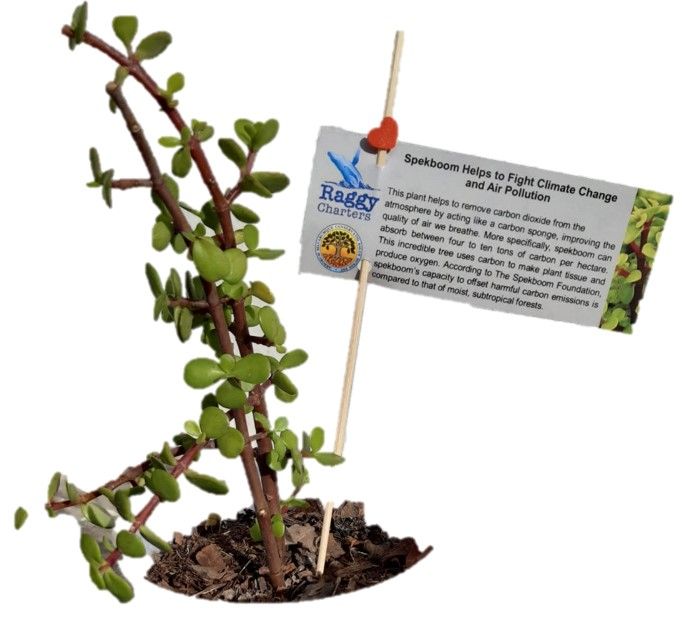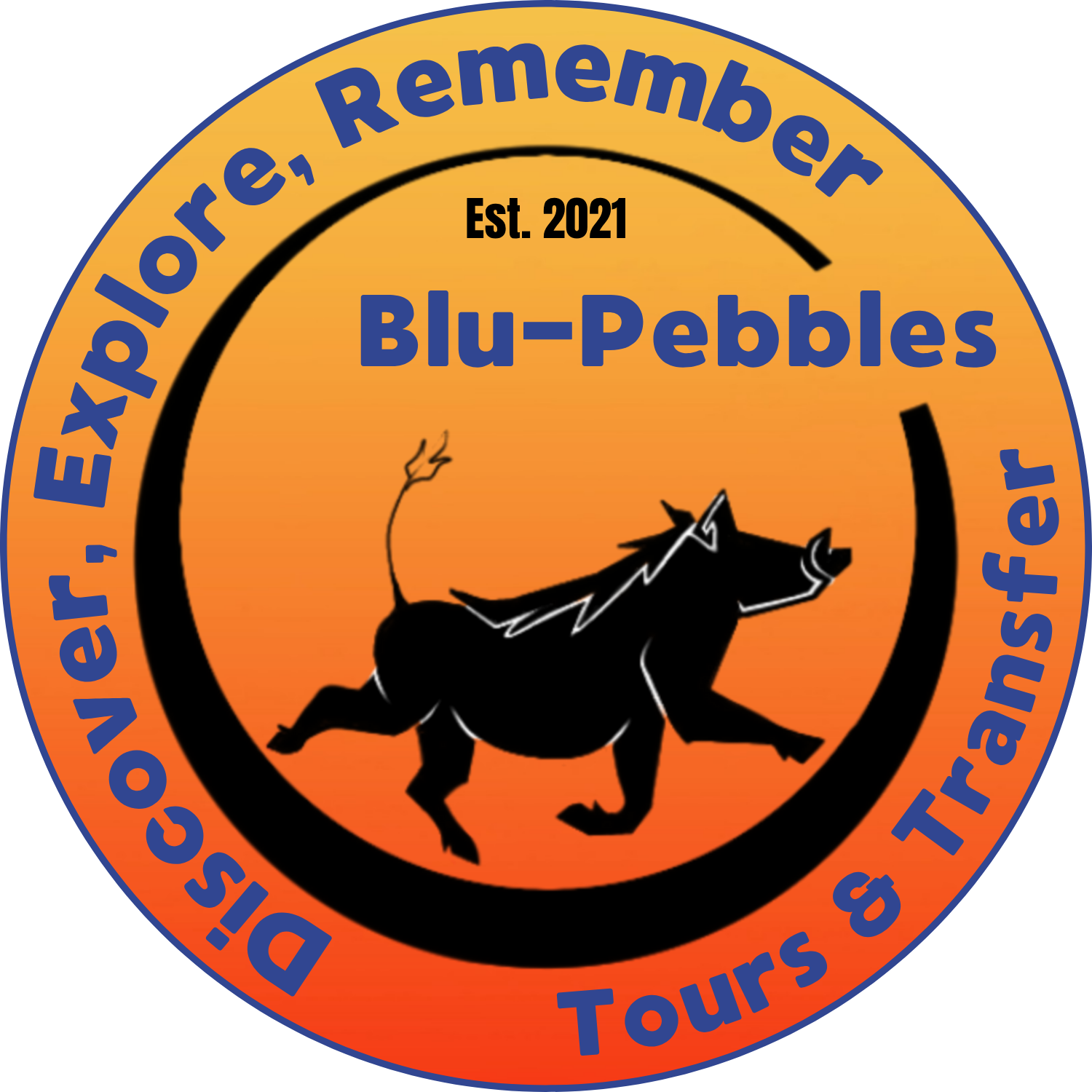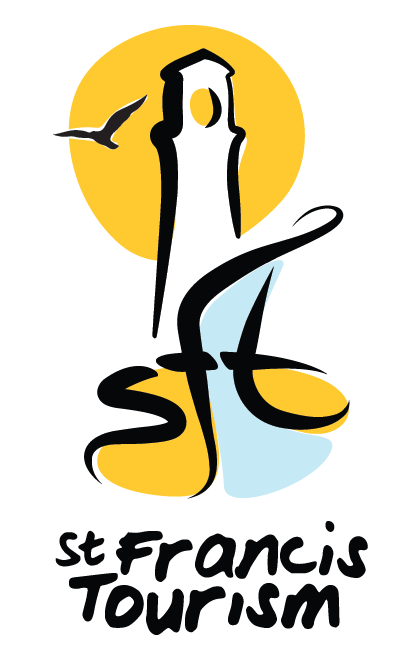Tree Planting in the Eastern Cape
Lloyd Edwards, owner of Raggy Charters, is the chairman of the Eastern Cape Dendrological Society, and as such is dedicated to promoting the knowledge, protection and propagation of trees and the preservation of tree-dominated ecosystems as a contribution to effective environmental conservation and improvement in South Africa.
Raggy Charters promise to plant at least one tree for every boat cruise done, in order to offset our carbon footprint. To get guests involved we are starting an initiative where each guest will be given a spekboom to plant in their gardens after enjoying the cruise with us. Their spekboom can be then planted in a garden of family or friends, at the guest house/ B&B they may be staying at or at the wonderful Spekboom Whale Garden on the City Lodge lawn at the Humewood Beachfront.

A portion of Lloyd's nursery at his home


We rehabilitate wetlands by tackling the problems of invasive alien species and planting indigenous trees and plants, and currently have 12 projects on-going around the Eastern Cape.
Our report on some of the projects we have worked on
Rehabilitation of Wetlands in the Eastern Cape
Whilst there are many areas that need rehabilitating, wetlands are probably a good place to start, as their healthy survival is vitally important and thus a priority, especially if one has limited resources.
According to the Ramsar Convention a wetland can be defined as “areas of marsh, fen, peatland or water, whether natural or artificial, permanent or temporary, with water that is static or flowing, fresh, brackish or salt, including areas of marine water the depth of which at low tide does not exceed six metres”. Since 2008, all six of the rehabilitation projects being undertaken by the Atalaya Branch can be classified as wetlands.
Once-off hacks are important, but something crucial is often missing, and that is proper follow-up operations. ‘Woking for Water’ also experiences this difficulty. What the Atalaya Branch has been attempting, is producing a formula that ensures that the entire rehabilitation process is ongoing. Each area identified for rehabilitation should also have a “custodian” who is in charge of the project and ensures that the follow up work is done regularly. Obviously, if this becomes too difficult for one person to manage, then enlisting the help of the local branch would be beneficial. Ideally that person should live nearby to such a wetland, thus avoiding excessive monitoring expenses.
How to start a campaign
After we had rehabilitated the lower Seaview wetland we learnt how to manage future projects. Upon identifying our next project, i.e. Cows Corner Wetland, we invited interested parties to gather at the wetland. Besides our own members from the Atalaya Branch we had ‘Working for Wetlands’ members, the Environmental Directorate of the municipality, forestry officials, the local DA councillor, and a business representative.
A public meeting was advertised by means of posters at businesses in the area and flyers were distributed to nearby residents. Businesses in the area were approached and money and services were pledged. At the meeting, held on the 17th February 2012, the author presented a slideshow on the Seaview Wetland which had now been rehabilitated. The Society Secretary, Carla Hazel, gave a talk on what was envisaged at this wetland, and the ‘Working for Wetlands’ team gave input on the importance of wetlands. The twenty-five people present agreed that work would start the following week (25th February). In the meantime, new posters were put up at the businesses, and flyers were dropped off at houses in the area, advertising the start of the programme. We also ran articles in the community newspaper. This format worked very well.
Seaview Wetland
The indigenous Phragmites australis is present and was being overwhelmed by this invader. The cut reed was sold and the proceeds used to continue funding the process. The invasive reed was allowed to grow back from the underground rhizomes, then, when it was approximately a metre in height, it was sprayed with a growth hormone (Touchdown) which in turn causes the reeds to grow very rapidly thus exhausting the rhizomes and weakening subsequent regrowth. This process was repeated three times before a marked reduction was evident.
Each application resulted in diminished growth. However, this remains an ongoing process. Obviously the regrowth of the other aliens required removal as the seed load remains viable for many years. Then, on the 29th July 2009, members of the tree society planted fifty trees in the cleared area. Those are now rapidly growing, possibly owing to the fact that the alien Acacia trees are nitrogen fixers in the soil.
We now do monthly visits to check on regrowth which has slowed down considerably. Presently our priority is preventing the newly planted trees from being overgrown by fast-growing indigenous shrubs, such as Chrysanthemoides monilifera (bush tickberry/bietou) and pink mallow. This wetland now attracts thousands of European swallows which roost here during the summer months. It is interesting to note that these swallows do not roost In Spanish reed, but require indigenous Phragmites australis.
Cows Corner Wetland
This was our next project. Fifty people gathered on a Saturday morning to offer their services. We had eight chain saws, a four wheel drive tractor, and some professional tree fellers at our disposal. Local business support was generous in terms of finance and refreshments. (It was immensely gratifying to see the first few alberta tumble).
We ensured that the volunteers were able to distinguish between wanted and unwanted trees. A few large trees were not felled as our resources were stretched. Besides which, we did not want to scare off the municipal workers with too much work! On our first attempt we managed to clear approximately 80% of the alien trees and removed three truck-loads of rubbish. In the weeks after the first session the municipality carted away the remaining wood. Once the last invaders had been removed we were ready to dig holes and plant trees. This took place on the 28th April and two hole diggers were supplied which eased the burden considerably.
Forty large trees were donated by a local nursery, and members. Somehow we received many loads of compost from an unknown donor. Every helper managed to plant at least two trees which were then watered by joining all the local businesses’ hosepipes together. Poles were put up around the trees and plastic pipes around the stems. The secretary of the Atalaya Branch, Carla Hazel, is the custodian and ensures regular follow-ups with the help of a labourer, funded by local businesses. Now, after two years, a great change is evident as most of the alien seed had germinated and been removed. It is remarkable to see how the indigenous trees are bouncing back. The vagrants that frequented this spot (hiding under cover of the aliens) have now relocated, much to the relief of local businesses and residents alike.
Parson’s Vlei Wetland
Parson’s Vlei used to be a beautiful wetland and is known to many people in Port Elizabeth. A former photographer and journalist, Colin Urquart, drew attention to the fact that it was becoming badly degraded and being used as a rubbish dump. Despite all the press releases, photographs and attention it received, nothing was done by the authorities.
After a request from ‘Working for Wetlands’ the Dendrological Society again began a campaign. We followed much the same modus operandi as previously. This time around we received more assistance in the form of the Bird Society, ‘The Friends of the Baviaanskloof’, and the Wildlife Society. This project caused quite a few headaches, but with perseverance we succeeded. Continual monitoring is essential
Baviaan’s Lodge, Kouga River Tributary, Baviaan’s Wilderness Area
The weekend away from Port Elizabeth to the Baviaan’s Lodge was a fabulous outing. Twenty-five of our members attended. The Atalaya Branch was grateful to the owner, Rob Le Roux, for his contribution in terms of accommodation and meals, and a good time was had by all. Eight of us arrived on the Friday night and, as a token of appreciation to the owner, this group cleared prickly pears at one of the cottages. Then, armed with our “weapons of mass destruction” – axes, pangas, pruning saws, and herbicide – we set off downstream towards the Kouga River. We managed to ring-bark at least twenty very large black wattles and twenty smaller ones. We cut off approximately one hundred saplings, and many wattle seedlings were pulled out. All debarked trees and stumps of the felled trees were sprayed with ‘Hatchet’ herbicide.
On our way back to the lodge we walked past a section of the valley that the owner had rehabilitated after the illegal felling of giant yellowwoods before he purchased the farm, fourteen years ago. It was astonishing to observe that yellowwoods that were planted next to Vachellia karroo (sweet thorn) were growing more rapidly than those without an accompanying sweet thorn! The reason being, that members of the legume family possess root-nodule bacteria which fix growth enhancing atmospheric nitrogen in the soil. Plant a few sweet thorns in your garden and see how well it works.
All had a scrumptious home cooked meal and copious amounts of wine and the festivities lasted well into the night. The following morning we set off to the Bushmen’s burial cave which has some spectacular paintings. We admired the ancient Portulacaria afra (Spekboom) and Boscia oleoides (Karoo shepherd’s tree/karoowitgat) at the entrance of the cave. After brunch we began the tree planting mission. The trees were donated by Mandy Fick and Andrea Durrheim from the ‘New Plant Nursery’ at Victoria Bay, as well as from Lloyd Edwards and Carla Hazel.
We received a request from the owner to keep the river that flows through his property and into the Kouga River alien-free. Compared with the other properties seen along the way, Rob has done a sterling job in keeping his property 99% wattle-free. We, as the Atalaya Branch, have now taken on the custodianship of this particular section and will visit it once a year.
Baakens River, Settler’s Park, Port Elizabeth
Krag Lohry, one of our members, invited us to have a meeting in Settler’s Park which is adjacent to his property. Well, on our arrival at the site, we could not believe our eyes as there were thousands of Port Jackson willows (Acacia saligna) and seedlings popping up all over the place. Although ring-barked by Krag previously, many showed regrowth.
The worst part of it was to see all the rare indigenous geophytes and other plants being smothered by the invaders. This area is part of the catchment for the Baakens River and Settler’s Park. We walked and were horrified to find aliens all around- this is in spite of the many organisations that have been formed to protect the valley! So we decided to make this yet another project.
Prince Alfred’s Pass, De Vlugt
“On retiring to De Vlugt in the Prince Alfred’s Pass late in 2011 we were overwhelmed with all the alien vegetation in the valley. However, with dedication and hard work we eradicated virtually all of them on our property. We often went, and still go for walks up the pass in the direction of Avontuur, and can clearly remember that, initially, we were able to pull up more than 200 small wattles during our walks. Yet, in the last two years, specifically the wattles have grown to such an extent that they have to be felled and the stumps treated with Garlon. Furthermore, their rapid rate of growth has resulted in increased danger whilst driving through the pass, as one is no longer able to see over them.
In light of the above we have, with the help of local farmers who kindly offer their labour on a sporadic basis, organised four felling operations alongside the road and in the river course. So far we have almost completed 1.3 kilometres from the hamlet of De Vlugt towards Avontuur. Much more remains to be done- significantly more than our capacity. The alien problem can really overpower one, but one has to stay focused and strategically work towards a common goal.
As the Prince Alfred’s Pass is of historical significance and is used as a main route linking Plettenberg Bay and Knysna with the hinterland, as well as that South Africa is known as a water-scarce country, it is important for us that eradication, with regular follow-up episodes, takes place. Of course, on top of that, our botanical heritage is rapidly being diminished by water abstracting and extremely fast growing invasive vegetation.
It is needless to say that our eradication exercises bring us tremendous satisfaction. It is now an absolute pleasure to walk or cycle where we have already cleared. There are always a few trees that one misses out, but we go back regularly to re-spray coppicing stumps and cut down the “beasts” that remain. During September 2014, members of the Atalaya Branch from Port Elizabeth visited us and we managed to pull up many small trees on our two respective walks. The encouragement that we got from our fellow members will spur us on to greater heights! May many more people become aware and recognise the immense problem of alien invasion in our beautiful country.
In conclusion
How to start a campaign
After we had rehabilitated the lower Seaview wetland we learnt how to manage future projects. Upon identifying our next project, i.e. Cows Corner Wetland, we invited interested parties to gather at the wetland. Besides our own members from the Atalaya Branch we had ‘Working for Wetlands’ members, the Environmental Directorate of the municipality, forestry officials, the local DA councillor, and a business representative.
A public meeting was advertised by means of posters at businesses in the area and flyers were distributed to nearby residents. Businesses in the area were approached and money and services were pledged. At the meeting, held on the 17th February 2012, the author presented a slideshow on the Seaview Wetland which had now been rehabilitated. The Society Secretary, Carla Hazel, gave a talk on what was envisaged at this wetland, and the ‘Working for Wetlands’ team gave input on the importance of wetlands. The twenty-five people present agreed that work would start the following week (25th February). In the meantime, new posters were put up at the businesses, and flyers were dropped off at houses in the area, advertising the start of the programme. We also ran articles in the community newspaper. This format worked very well.
Read more about this interesting plant:





















